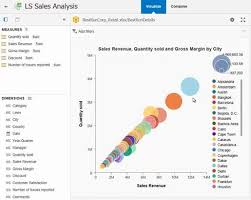The Power of SAP Data Analytics
In today’s data-driven world, businesses are constantly seeking ways to harness the power of data to make informed decisions and drive growth. SAP, a leading provider of enterprise software solutions, offers a comprehensive suite of data analytics tools that enable organisations to unlock valuable insights from their data.
What is SAP Data Analytics?
SAP data analytics encompasses a range of tools and technologies designed to help businesses collect, analyse, and visualise their data effectively. By leveraging SAP’s powerful analytics platform, organisations can gain a deeper understanding of their operations, customers, and market trends.
Benefits of SAP Data Analytics
Improved Decision-Making: With SAP data analytics, businesses can access real-time insights that enable faster and more informed decision-making.
Enhanced Efficiency: By automating data processing and analysis tasks, SAP analytics tools help streamline business operations and increase efficiency.
Predictive Capabilities: SAP offers predictive analytics features that allow businesses to forecast trends and anticipate future outcomes based on historical data.
Use Cases for SAP Data Analytics
SAP data analytics can be applied across various industries and business functions:
- Financial Services: Analyse market trends, manage risk, and improve customer engagement.
- Retail: Optimise inventory management, personalise marketing campaigns, and enhance customer experience.
- Manufacturing: Monitor production processes, identify inefficiencies, and ensure product quality.
- Healthcare: Analyse patient data, improve treatment outcomes, and streamline healthcare operations.
Conclusion
The power of SAP data analytics lies in its ability to transform raw data into actionable insights that drive business success. By harnessing the capabilities of SAP’s advanced analytics tools, organisations can gain a competitive edge in today’s fast-paced digital landscape.
Unlocking Business Potential: The Top 5 Advantages of SAP Data Analytics
- Real-time insights for informed decision-making
- Automated data processing and analysis for increased efficiency
- Predictive analytics capabilities for trend forecasting
- Versatile application across multiple industries and business functions
- Enhanced data security and compliance measures
Challenges of SAP Data Analytics: Navigating Complexity, Cost, and More
- 1. Complexity
- 2. Cost
- 3. Integration Challenges
- 4. Scalability Issues
- 5. Dependency on IT Support
- 6. Customisation Limitations
Real-time insights for informed decision-making
SAP data analytics offers the invaluable benefit of providing real-time insights for informed decision-making. By leveraging SAP’s advanced analytics tools, businesses can access up-to-the-minute data analysis that enables quick and well-informed decisions. This capability allows organisations to respond promptly to changing market conditions, identify emerging trends, and seize opportunities as they arise. With real-time insights from SAP data analytics, businesses can stay agile and competitive in today’s dynamic business environment.
Automated data processing and analysis for increased efficiency
Automated data processing and analysis through SAP data analytics offer a significant advantage by enhancing operational efficiency within organisations. By automating tedious data tasks, such as data cleansing, transformation, and analysis, businesses can save time and resources while improving the accuracy and speed of decision-making processes. This efficiency gain allows teams to focus on interpreting insights and implementing strategic actions based on the analysed data, ultimately leading to more effective and timely business outcomes.
Predictive analytics capabilities for trend forecasting
SAP data analytics offers a significant advantage with its predictive analytics capabilities for trend forecasting. By utilising advanced algorithms and historical data analysis, SAP enables businesses to anticipate future trends and outcomes with accuracy. This proactive approach empowers organisations to make informed decisions, mitigate risks, and seize opportunities before they arise. Predictive analytics through SAP data analytics not only enhances strategic planning but also helps businesses stay ahead in a rapidly evolving market landscape.
Versatile application across multiple industries and business functions
One key advantage of SAP data analytics is its versatile application across a wide range of industries and business functions. From financial services to retail, manufacturing to healthcare, SAP’s analytics tools can be tailored to meet the specific needs of diverse sectors. This flexibility allows organisations to leverage data-driven insights effectively, whether it’s for optimising operations, improving customer engagement, or enhancing decision-making processes. The ability of SAP data analytics to adapt and deliver value across various industries underscores its significance as a powerful tool for driving business success in today’s dynamic marketplace.
Enhanced data security and compliance measures
Enhanced data security and compliance measures are a key advantage of SAP data analytics. By utilising SAP’s robust security features, businesses can safeguard their sensitive information and ensure compliance with data protection regulations. With encryption, access controls, and audit trails, SAP data analytics provides a secure environment for storing and analysing data, giving organisations peace of mind knowing that their data is protected against cyber threats and unauthorized access.
1. Complexity
One significant drawback of SAP data analytics is its complexity. Implementing SAP data analytics tools can be a challenging task that demands specialised training for users to effectively utilise the software. The intricate nature of these tools may pose a barrier for some organisations, requiring additional resources and time to navigate and fully leverage the capabilities of the platform.
2. Cost
The cost associated with SAP data analytics solutions poses a significant challenge, particularly for small to medium-sized businesses. The initial investment required to implement SAP data analytics tools, along with the ongoing maintenance costs, can be substantial and may exceed the budget constraints of smaller enterprises. This financial barrier could hinder access to the valuable insights and capabilities offered by SAP data analytics, limiting the adoption of these advanced technologies among businesses with limited resources.
3. Integration Challenges
Integration Challenges: One significant drawback of SAP data analytics is the potential integration challenges it presents. Incorporating SAP analytics tools into existing systems and databases can be complex and time-consuming, leading to compatibility issues that demand additional resources for resolution. This hurdle may hinder the seamless implementation of SAP data analytics within an organisation, requiring careful planning and dedicated efforts to ensure smooth integration without disruptions to existing operations.
4. Scalability Issues
Scalability can pose a significant challenge when it comes to SAP data analytics. As data volumes and user demands increase, expanding SAP analytics solutions to meet these growing needs may present obstacles. Ensuring that the infrastructure can handle the influx of data and users while maintaining performance and efficiency requires careful planning and resource allocation. Failure to address scalability issues effectively could result in system slowdowns, data processing delays, and overall performance degradation, impacting the effectiveness of data-driven decision-making within an organisation.
5. Dependency on IT Support
Businesses that utilise SAP data analytics may encounter a significant drawback in the form of dependency on IT support. This reliance on IT assistance for troubleshooting and maintaining SAP data analytics tools can result in potential delays in analysis processes. The need for constant technical support may hinder the agility and responsiveness of businesses, impacting their ability to extract timely insights from data and make informed decisions swiftly.
6. Customisation Limitations
Customising SAP data analytics tools to align with specific business requirements can be challenging due to customisation limitations. Tailoring the tools to meet unique needs may necessitate additional development work, resulting in extra costs for the organisation. This constraint could potentially hinder the flexibility and scalability of the analytics solution, making it less adaptable to evolving business demands without significant investment in customisation efforts.






